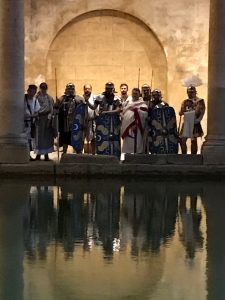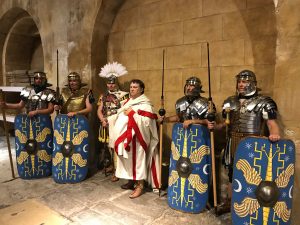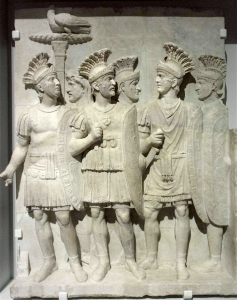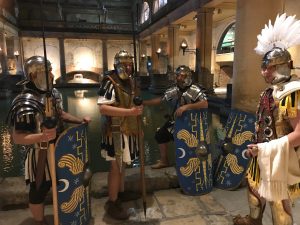 Britannia’s Praetorian unit.
Britannia’s Praetorian unit.
3rd Cohors Praetoria Britannia
During one of Britannia’s Gladiator Guildhall Shows for the Museum of London, members John Wheeler and Marc Byrne were discussing the

feasibility of fielding an ‘in house’ unit of elite bodyguards for the game’s editor (Sponsor). Normally a group member like Robert Moore or James Byrne gets to play a visiting Emperor, Young Caesar or Britannia’s Imperial Governor to add to the spectacle of the show.
The discussion led to more definite plans and soon members Kerry Ballard & Dylan Carter got involved, with the latter deciding to invest in some spectacularly blingy Praetorian Centurion’s kit. The III Cohors Praetoria Britannia were born.
The unit grew quickly, plenty of research was done and within 2 years we had a small Praetorian unit. The reaction was so positive from the public and clients that we found our unit was booked by Howard Giles events to debut successfully at a large function in the prestigious World Heritage site of Roman bath.
The Praetorian guards (Imperial bodyguards)
Before the time of the emperors, (in the old Roman Republic), some Roman officers picked units of the best soldiers to guard them. These units weren’t really official but started to be called Cohors Praetoria. (Their name is thought to have come from the ‘Praetorium’, the large tent belonging to the general in the Roman army camp, their job was to guard it). In 2BC Rome’s first Emperor Augustus made the unit more official.
He then appointed two prefects as commanders. The Praetorians were mainly stationed in Rome and there are many disagreements about what their armour and equipment actually looked like. (In the Imperial palace, on duty, many of them wore togas). One of the most distinct images of Praetorian guards is on what’s now called The Louvre Relief, (a carving of troops that probably came from the arch of Claudius, erected in 51AD). This shows them in the ‘Attic’ style of helmets, which is thought of as artistic licence, to make these elite soldiers look more distinct. Sometimes the Emperors themselves would go to war and on these campaigns, they would take the Praetorian Guards with them.
(In the Imperial palace, on duty, many of them wore togas). One of the most distinct images of Praetorian guards is on what’s now called The Louvre Relief, (a carving of troops that probably came from the arch of Claudius, erected in 51AD). This shows them in the ‘Attic’ style of helmets, which is thought of as artistic licence, to make these elite soldiers look more distinct. Sometimes the Emperors themselves would go to war and on these campaigns, they would take the Praetorian Guards with them.
When in battle, the Praetorian Guards probably dressed very similar to most Roman legionaries. But because they had to guard the Emperor, their equipment was likely to be much better in quality than the average legionary. Their pay was much better than that of the average Roman soldier. Also, they only had to serve for 16 years in the army. (The average Roman soldier had to serve for 25 years). They also got a huge pay bonus every time a new Emperor came to the throne. They were not always popular, they sometimes forced the Roman senators to accept their choice of new Emperor (like Claudius) and sometimes they would kill emperors they didn’t like, (such as the ‘mad’ emperor Caligula). The Emperor Constantine disbanded the Praetorian guards in 312 AD. They had chosen to support his rival, Maxentius.

Constantine beat this rival’s army in battle and upon arriving in Rome, the power of the praetorian guards was finally ended.
